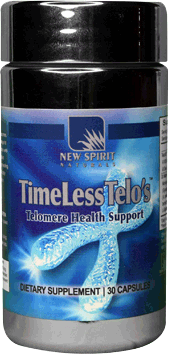Benefit Summary
Research shows that certain nutrients play a key role in protecting and even increasing the length of telomeres in the body. Short telomeres decrease the ability of healthy cells in the body to divide and function properly resulting in accelerated aging and disease. TimeLess Telo's contains patent pending, natural compounds shown to help maintain telomere health including Moringa - one of the most nutrient-dense plants on the planet.
What Are Telomeres?
Telomeres are repetitive DNA sequences at the ends of linear chromosomes that serve as essential protective structures that help maintain the integrity of chromosomal DNA. The word telomere is derived from two words - telo (end) and mere (segment). It has often been compared to shoe laces with an end cap. When the end caps begins to lose integrity, the laces begin to fray. This is quite similar to what happens to humans with each cell division. In newborns, telomere length varies from about 8,000-13,000 basic pairs (DNA letters) in length. By age 35, we may lose up to 30-40% of our base pairs and by age 65 as much as 50-60%.
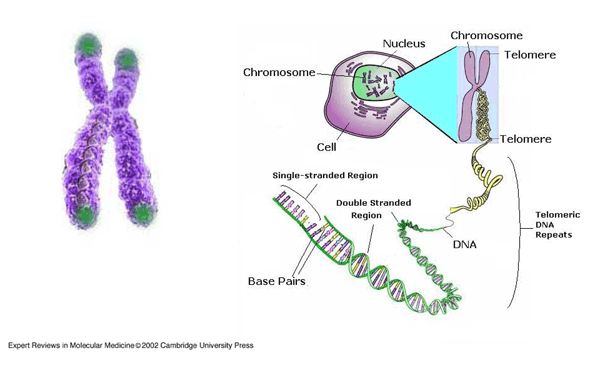
|
Each time a normal human cell divides, some telomeric DNA sequences are lost. In cross-sectional studies, humans lose telomeric DNA at a very modest rate of about 15-60 base pairs per year. 1 Some researchers suggest that this may be as high as 200 base pairs with each cell division. Stress and chronic viral infections accelerate telomere loss and premature aging.
When telomeres become short, cells enter an irreversible growth arrest state called Replicative Senescence or aging. 2
There is mounting evidence that short telomeres coordinate with age-associated disease by limiting the ability of tissues to regenerate. This has led researchers to hypothesize that telomere length may be a reliable indicator (or biomarker) of biological aging.3
Telomere length measurement of the average and shortest telomeres, provides a molecular determinant about one's overall health.3
|
Likely Causes of Shorter Telomeres
|
Some people are born with shorter telomeres and this causes them to age faster. In addition, it has been shown that environmental stressors such as smoking, inflammatory disease, lack of modest exercise, excessive drinking, chronic stress, lifestyle factors, nutrition and sleep quality can lead to increases in oxidative damage and premature telomere shortening.
|
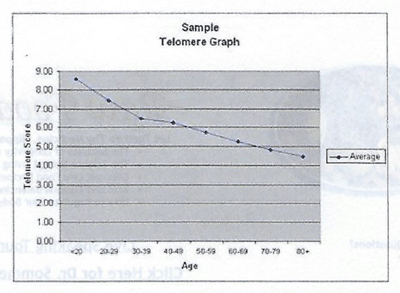
|
Shorter Telomeres Lead to Replicative Senescence
Telomere length is a record of the history and potential for replication of human cells.4 A body of epidemiological and clinical data is suggesting that relatively short telomeres and accelerated telomere shortening are linked to factors that define aging and diseases of aging in humans.3
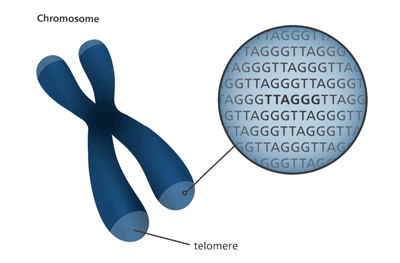
|
There is experimental support that most human proliferative tissues and organs including somatic cells (even stem cells of renewal tissues) undergo progressive telomere shortening throughout life.2 The evidence that it is causal has now been directly documented.5
Clinical studies now point to a causal relationship between telomere loss, cell aging, reduced tissue regeneration, loss of structure and function. In addition, epidemiological studies show that short telomeres in humans are a risk factor for Atherosclerosis, Hypertension, Cardiovascular disease, Alzheimers disease, Infections, Diabetes, Fibrosis, Metabolic Syndrome, Neurodegenerative diseases, Testicular, Splenic, Intestinal Atrophy, Cancer and overall Mortality.1 As such, telomere length is now recognized as a marker of biological age.
|
Can the Body Repair Itself?
The body produces an enzyme called telomerase. Telomerase synthesizes the specific DNA sequence (TTAGGG) at telomeres, the terminal DNA at the end of all chromosomes.1 This telomerase is activated in fetal development (before birth), thus protecting our telomeres from significant loss during our period of dramatic cell expansion.1 Birth marks the beginning of telomeric erosion. All adult somatic stem cells appear to be capable of activating telomerase during tissue regeneration. However, these periods of activation are insufficient to prevent telomeric loss. It is further compounded by a decreased ability to activate telomerase during aging and stress.6 As such, stress can accelerate telomeric loss by increasing cell turnover and the amount of telomeric DNA lost per cell division.1 Because of the result of oxidative damage and degradative processing, there is insufficient telomerase activity to maintain telomere length. This accounts for the loss of telomeric DNA at the very modest rate of (mentioned prior) about 15-60 bp per year.
How Can One Determine the Current Status of Their Telomeres?
In order to track telomere lengths and potentially slow down or reverse the increased probability of telomere associated diseases one would have to turn to a Telomere Clinical Diagnostic Assay test. As of this date, several telomere tests have been developed and are continually being upgraded based on research. There are two main types of tests.
One test measures average length of telomeres. This is less expensive (approx. $100 - $250.00 USD) and quicker. It requires a small drop of blood which can be done at home. The disadvantage is that this test reveals an average and does not stress single telomere length within individual cells.
Another more scientific test provides not only the average telomere length per cell and the number and distribution of the shortest telomeres in individual cells.7 This test is quite expensive (up to $1,000 USD). This test requires the person being tested to obtain a kit thru a medical professional and a blood draw thru a medical laboratory. This test can distinguish critically short telomeres on one cell that may be triggering senescence.
What Can Be Done Naturally to Help Activate and Increase the Enzyme Telomerase (The telomere repair enzyme)?
Several studies have suggested that that activation of telomerase is sufficient to delay aging and increase the lifespan in normal aging. Given the projected increase in life span of the human population, healthy aging might be facilitated by approaches that help maintain telomere length.
There are natural compounds now available that help to repair telomere length and that are associated with increased longevity through telomerase activation and stopping the telomere erosion.
TimeLess Telo's contains a host of ingredients including Telos95 which has been shown to reduce Teloyear cellular age up to 8.52 years.
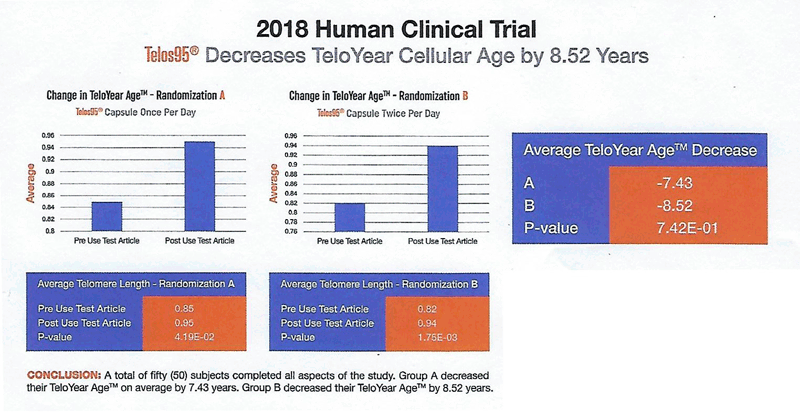
Telos95
Dr Milam, chief researcher and formulator at New Spirit Naturals has been researching telomeric erosion (TE) and its association with increased cellular senescence and aging for the past 25 plus years. After studying and evaluating many potential telomeric enhancing ingredients, Dr. Milam has selected a special branded ingredient known as Telos 95 as the foundation of his new TimeLess Telo's product. This branded ingredient was selected after reviewing its human clinical trial conducted by one of the most advanced telomere testing laboratories. While there were other ingredients that claimed telomeric enhancing benefits, they were mostly mice studies and not actually human studies.
Even though studies have confirmed Telos95 can decrease cellular age between 7.43 to 8.52 years when used at a prescribed dose daily, Dr. Milam has developed his own proprietary "Tree of Life/Immortality, Longevity and Vitality" natural herbal blend. This proprietary blend incorporates seven (7) selected ingredients that Dr. Milam personally endorses and that he believes makes Timeless Telo's the most unique and effective Telomeric enhancing product on the market today.
Dr. Milam's Tree of Life/Immortality Longevity & Vitality Blend
Moringa (Moringa oleifera) The "Tree of Life"
Moringa is said to be the most nutrient-dense plant to be identified in our history. It has the highest protein ratio of any plant - outperforming that of soybeans. The Moringa tree is bursting with vitamins, minerals antioxidants, anti-inflammatories & Omega 3-6-9. We have included it in TimeLess Telo's because it contains the highest source of Zeatin (6[4-hydroxy-3methyl-but-2-enylamino] adenine) of any known plant. Adenine is a member of the plant hormone family known as cytokinins; which are best known to induce cell division, growth and delay aging.8 Moringa contains several thousand times the amount found in coconut oil which until recently was thought to be the best source. Zeatin in Moringa can stimulate the production of more telomerase, the enzyme which repairs telomeric erosion.8
In addition, it contains 46 enzymatically active antioxidants as well as 36 anti-inflammatories.9
In 2008, the National Institute of Health named Moringa the "Plant of the Year" acknowledging that "perhaps like no other single species, this plant has the potential to help reverse multiple environmental problems and provide many unmet human needs".14
Dr. Howard N. Fisher stated "If you want to protect your ability to reproduce existing cell lines, it (Moringa) is critical to protect your chromosomes. The antioxidants in Moringa oleifera afford a protective shield to do so."10 14
Astragalus Root
Astragalus root has been used for over 2,000 years in Chinese Medicine because of its anti-aging benefits. Astragalus contains two substances - cycloastragenol and astragalosides that activate telomerase to help prevent your telomeres from shortening.15 According to Chinese Medicine and Daoist philosophy, it is the depletion or imbalance of Chi that underlies most all disease and dysfunction in the body. Astragalus, according to Chinese medicine, strengthens upright Chi. Normally, as most people get older the upright Chi is depleted, which is why many elderly people are often hunched over to some degree. Daily use of Astragalus works to reverse this trend by supplying upright Chi and telomere enhancers. Upright Chi also helps position the organs of the body in their proper places within the body. 16
Ashwagandha (Withania Somnifera)
Aging is a deceleration unidirectional process of life. Shortening of telomeric DNA, the hexanucleotide repeats, which forms the caps at the chromosome ends, is implicated to determine the aging process and the healthy lifespan. Ashwagandha root extract has been shown to enhance telomerase activity in the HeLa cell line by 45% at relatively small doses.17
Glutathione
Glutathione plays an essential role in supporting immune health and protects cells from the damaging effects of oxidative stress and toxins. Glutathione supports the function of the liver, kidneys, GI tract and intestines - the body's detoxification pathways. Glutathione is found in every cell in the body and critical to preserving cellular integrity and referred to as the "master antioxidant".
Schisandra chinensis (5 Flavor fruit)
This berry gets its name from Wu Wei Zu (five flavored berry) due to the fact that it is sweet, sour, salty, bitter and pungent. Schisandra enjoys millennia of traditional use for prolonging life, retarding the aging process, increasing energy, a fatigue fighter and sexual tonic. It is reported in traditional Chinese medicine to tonify all three Treasures, enter all twelve meridians and nurture all five elements. It is said to have the most influence on the Kidney, Lung, Liver and mental functions (mental fatigue, increased accuracy and quality of work).
Five-Leaf Gynostemna, Pentaphyllum (Jiaoqulan) "The Herb of Immortality"
Gynostemna has been historically used to increase endurance and stamina. Its documented history dates back to the Ming Dynasty (1368-1644) when it was harvested as a food. Now we know that this traditional herb activates AMPK (Adenosine Monophosphate-activated Protein Kinase). AMPK has been referred to as "metabolic master switch". AMPK controls a gamut of metabolic pathways that enables all mammals to extract energy from food and store and distribute that energy safely throughout the body. The central core role of AMPK is to sense each cells energy status at every moment and to trigger responses that maintain the cells energy at precisely the optimum level. There is a growing body of evidence that suggests that boosting AMPK activity can prevent and even reverse life shortening effects of aging.11
This herb grows wild in the remote mountains of Guizhou Province in Southeast China. This happens to be an area where the local people were achieving unusual longevity and vitality, living well beyond 100 years of age. In 1979 the Chinese government sent researchers to investigate this anomaly. What they found was astounding. Many of these centerarians in the Guizhou region were consuming the herb Gynostemna daily as a tea, rather than consuming green tea as most Chinese do. The locals name it "Xiancao", the "Immortality herb".
There are approximately 300 animal and human studies documenting this herbs amazing benefits. One benefit is that Gynostemna actually stimulates the production of all three of the body's most powerful antioxidants – superoxide dismutase, glutathione peroxide and catalase. These are all absolutely vital for good health and longevity but difficult or impossible to obtain thru the diet. In one study, a group of old mice were divided into two groups. After four months, all the mice in the control group died while only 50% of the mice in the Gynostemna group died.13
In another study, the lifespan of fruit flies increased by as much as 50% when given 5-leaf Gynostemna. Other animal studies have demonstrated increase in lifespan.13
Resveratrol
Resveratrol has been shown to deeply penetrate the center of cells nucleus, likely providing DNA time to repair free radial damage.18 Research dating back to 2003 showeelectedd that Resveratrol, a powerful polyphenol and anti-fungal agent, was able to increase the lifespan of yeast cells.
A group of researchers from Japan led by Yoshinori Katakura have added a potential explanation for the mechanisms that delay aging in human fibroblast cells. In one experiment they treated cells with Resveratrol which causes more SIRT-1 protein to be made. The results suggest that the more SIRT-1 protein present, the longer the cells grow and the more aging features of the cell are delayed.12
Directions
For best results based on the clinical study, two capsules per day are recommended. (One capsule in the am and one capsule in the pm).

References:
1. Harley, Calvin B et al. "A natural product telomerase activator as part of a health maintenance program" Rejuvenation research vol. 14,1 (2011): 45-56.
2. Harley CB, Futcher BA, Greider CW. Telomeres shorten during aging of human fibroblasts. Nature. 1990; 345:458–460.
3. Jerry W. Shay. The University of Texas Southwestern Medical Center at Dallas Dept. of Cell Biology Dallas, TX. Aging and the Telomere Connection.
4. Aviv, A. Telomeres and human aging: facts and fibs. Sci. Aging Knowledge Environ. 51:pe43; 2004.
5. Bodar AG, Quellelte M, Frolkis Metal, 1998 Extension of Lifespan by Introduction of telomerase into normal human cells. Science 279.349-352
6. von Zglinicki, T. Oxidative Stress Shortens Telomeres. Trends Biochemical Sci 2002 Jul:27(7); 339-344
7. Lifelength.com US Patent N08,084203B
8. Discover moringa's nutrient profile and health benefits. https://daunaru.com/moringa-facts/
9. Five Moringa Nutrients That Can Help You Look Younger, Feb 06, 2017
https://moringamio.com/blogs/moringamio-blog/6-moringa-nutrients-that-can-help-you-look-younger
10.The Moringa Antioxidant Assortment, Telomeres and Aging, Dr. Howard Fisher.
11. AMPK and Aging, Reagan Linton. Life Extension Magazine 2015
12. BioChemical and BioPhysical Research Communication, 2011
13. Study of Chinese Patent Medicine 1998:10 (3):25 History of Jiaoqulan https://www.majesticherbs.com/history
14. Discover moringa's nutrient profile and health benefits. https://daunaru.com/moringa-facts/
15. Fauce, S. R., Jamieson, B. D., Chin, A. C., Mitsuyasu, R. T., Parish, S. T., Ng, H. L., ... & Effros, R. B. (2008). Telomerase-based pharmacologic enhancement of antiviral function of human CD8+ T lymphocytes. The Journal of Immunology, 181(10), 7400-7406.
16. The Extraordinary Benefits of Astragalus Root: The Ancient Herb of Longevity & Strength by Justin Faerman
17. Raguraman, V. and Subramaniam, J. (2016) Withania somnifera Root Extract Enhances Telomerase Activity in the Human HeLa Cell Line. Advances in Bioscience and Biotechnology, 7, 199-204. doi:10.4236/abb.2016.74018.
18. Six "Grow Younger Nutrients" mercola.com/articles May 9, 2012

